What is SKUs and Why It Matters for Every Retailer?
July 27, 2025
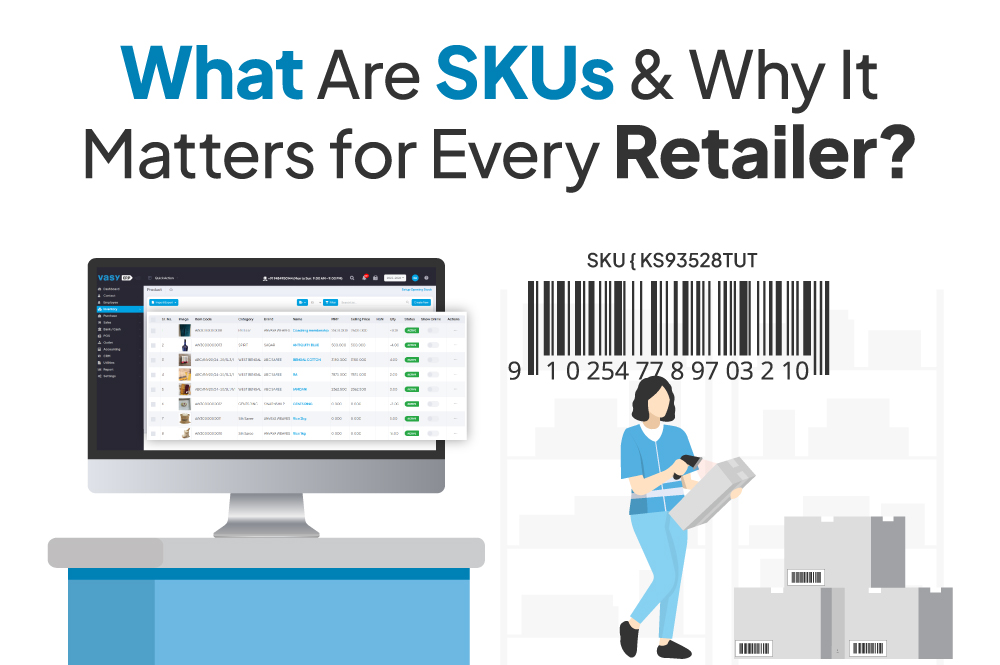
SKUs or stock keeping units are a blend of characters and digits that assist retailers and owners to track products, manage inventory, and ease overall operations. This blog explains details about SKUs, how they are different from barcodes and UPCs, and their importance in boosting retail efficiency, sales insights, and customer satisfaction.
A Stock keeping unit (SKU) is a unique identity of every product that makes inventory management and tracking easier. These identifiers are an important part of the inventory as they allow owners to easily manage stock levels across systems and sales channels. Effective product management is essential for the success of your company, and SKUs are essential to effective product management.
Imagine a chaotic store with shelves full of multiple products. How do staff members handle this chaos while maintaining efficient operations and satisfied clients? The SKU number is a fair solution to this problem.
A SKU number is used to identify and monitor products resulting in hassle-free inventory management.
So, whether you are a small retailer or a wholesaler, you will have made a large investment in stocks, which is the main pillar of your purchasing, inventory, and sales process. Seamlessly managing all the SKUs is important for the expansion and growth of your company.
Here, in this guide we will discuss what SKU is, its benefits, and why is it important for business owners?
Stock Keeping Unit (SKU) is an alphanumeric code that businesses give to every product to make the inventory more organized and easily manageable. SKU numbers are typically eight to twelve characters long, and each character reflects a distinct feature of the product it represents, such as the type, brand, style, or department to which the item belongs.
Additionally, SKUs vary according to the business industry. They are specific to your company and should include the answers to the most common questions your vendors or customers have regarding the products you sell. Different companies use SKU numbers to identify things, depending on the products you are dealing in.
SKU numbers typically range between 8-10 alphanumeric characters. It is important to understand that SKUs are not random. The codes in SKUs are dependent on unique features of the product like price, size, colour, and manufacturer and are organized according to importance so it becomes easy to scan the required information.
For instance, if you are the owner of the clothing store, you will create an 8-digit SKU number. The first two digits in the SKU will represent the product category (t-shirt, shirt, etc.) and the next two numbers in SKU reparents style (V-collar, Collar, Oversized, etc.) and the following 2-digit represent its colour and the final 2-digits shows the stock count of the product.
SKU Code: TS- BLM- A101
Here,
Businesses can strategically organize their warehouses with the help of this type of categorization and can generate a thorough catalogue of every product they own when paired with retail inventory management software. This implies that when a customer order comes in, they are aware of exactly what they have on hand and where to find it.
To ensure precise inventory management, every SKU needs to be distinct. Steer clear of duplicate SKUs, even if they are identical product variations.
You have two options for managing SKUs: Manually or Automatically.
The easiest method to get Stock Keeping Unit (SKU) numbers is through an inventory management software (IMS) or point-of-sale (POS).
Both customer orders and the warehouse item status are tracked by these SKU systems. Because most products have an automated SKU code generation feature, each product that is entered into your system will be assigned a unique number.
You will be able to make several SKUs and as needed if you run a retail business with a small product catalogue and turnover. Also, you will need a systematic approach to determine the key characteristics of your products to accomplish this.
Product attributes including supplier information and product category are defined by the first two letters of the SKU. Increasingly specific product attributes, including colour, size, or brand, are represented by the following SKU characters.
As a unique identification, the final SKU character or characters indicate how many things you have and what order they were bought or processed.
Create codes that have visual meaning whenever you can, such as the initial letters of a brand or supplier’s name. Your SKUs will be simpler to identify and handle manually as a result.
Additionally, if you ever decide to switch to a digital tool, keep your SKU numbers inside 10 characters to ensure they are compatible with third-party software.
Are you trying to find an SKU number? There are multiple places where you can place a SKU number:
Having problems? Check out a code that is 8-10 characters long and has alphanumeric characters; this is the simplest method to identify the SKU. When scanning a barcode, make sure it matches the SKU and not another code, such as the GTIN or UPC.
| Parameter | SKU (Stock Keeping Unit) | UPC (Universal Product Code) | Barcode | GTIN (Global Trade Item Number) |
| Definition | Businesses use internal alphanumeric codes to monitor inventory. | UPC consist of 12-digit numeric code which is used to monitor items | Data represented visually (lines, dots, QR codes) that scanners can read. | Numeric code standard for identifying trade items globally |
| Purpose | Internal inventory and stock management | External product identification for retail & supply chain | Machine-readable version of a product code | Standardized global identification of products |
| Global Standard | No (company-specific) | Yes (managed by GS1 US) | Depends on type (UPC, EAN, Code128, etc.) | Yes (managed by GS1) |
| Uniqueness | Unique within a company | Globally unique | Depends on encoded data | Globally unique |
| Length & Format | Varies (alphanumeric, user-defined) | 12-digit numeric | Varies by type (can represent SKU, UPC, or GTIN) | GTIN-8, GTIN-12, GTIN-13, or GTIN-14 |
| Human-readable? | Yes | Yes | No (visual lines or symbols; data may be shown underneath) | Yes (the GTIN is printed below barcode) |
| Example | SKU12345 | 036000291452 | NA | 0036000291452 (GTIN-13 version of UPC) |
| Where used | Internally by retailers, warehouses | Retail stores, POS systems, packaging | Scanned at retail, warehouses, shipping | Online marketplaces, global logistics, retail chains |
| Who Creates It | Retailer or company | GS1-authorized manufacturers | Generated based on product codes | GS1 assigns GTIN prefixes |
| Can It Be Printed as a Barcode? | Not inherently; must be encoded into a barcode format | Yes (UPC-A format barcode) | Barcode is the printed/scanned format | Yes (as EAN-13, ITF-14, DataBar, etc.) |
Businesses that leverage SKUs for inventory management and categorize their products can benefit from the following major benefits.
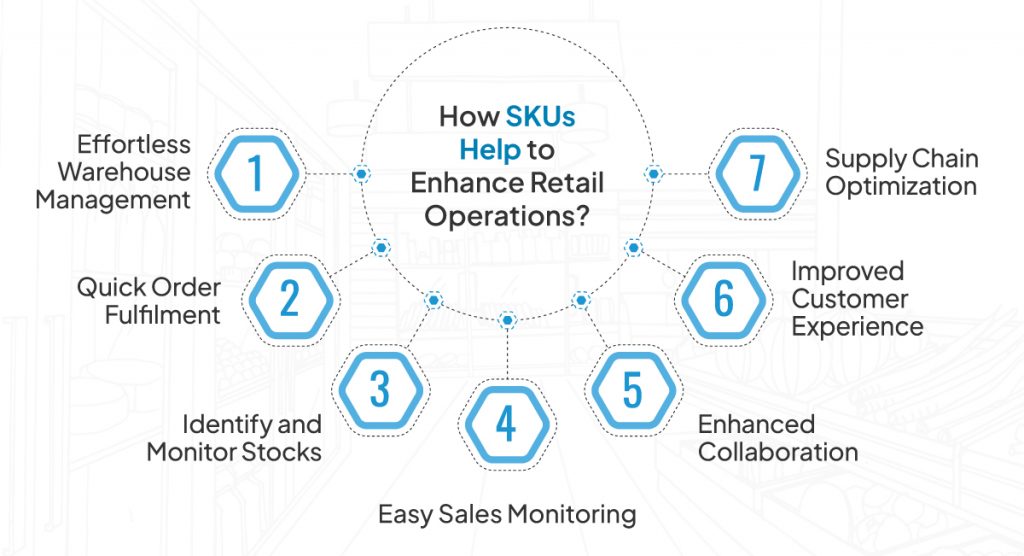
SKUs give companies the ability to group their products according to certain characteristics. By providing organizations with a way to classify products based on shared qualities, this makes effective warehouse management possible and ensures that every product is in the exact location needed for simple retrieval.
Finding the accurate product according to requirement is made easier using an SKU. Businesses can use their inventory management system (IMS) to quickly locate the goods in the warehouse, search for it, pack it, and dispatch it once a client placed an order.
In addition to increasing order fulfilment efficiency, this offers the final consumer a more dependable and consistent service.
Because each product has a unique SKU, companies are able to quickly and accurately count their stock and enter the results into their inventory management system.
As a result, they can prevent stockouts by ordering the proper inventory at the correct moment. Businesses can also lessen the risk of inventory shrinkage by using the detailed information provided by unique SKUs.
The ability of management teams to more precisely measure sales using SKUs is a lesser-known advantage. Business decision-making greatly benefits from knowing which items sell the quickest and yield the highest profits.
For example, businesses may utilize SKU data to manage stock, coordinate marketing activities, and even place their best-selling items at eye level on store shelves to capitalize on demand if it reveals that a particular t-shirt consistently sells out quickly. All of this results in more consistent sales income and company expansion.
SKUs are defined as a company’s internal language. Collaborating across teams is simple when all employees are on the same page regarding the format.
For instance, a sales representative can just give their manager the SKU and extract all the information they require if they wish to give a customer further specifics about a certain product. Explaining product descriptions that are prone to confusion is far more difficult than this.
SKUs speed up response times by enabling customer support agents to rapidly determine whether a company has a product in stock.
After a customer makes a purchase, comparable SKU items are suggested by automated recommendation systems that businesses can set up online. When combined, these advantages enable businesses to provide outstanding client experiences.
Improved supply chain visibility, from production to store shelves, lowers the chance of stockouts and allows for proactive inventory management. Retailers can spot any delays and take corrective action before they affect sales by using real-time tracking with SKUs.
Before they affect sales, identify possible disruptions and take appropriate action. Retailers can spot supply chain bottlenecks and take preventative action to avoid delays and stockouts by examining SKU-level data.
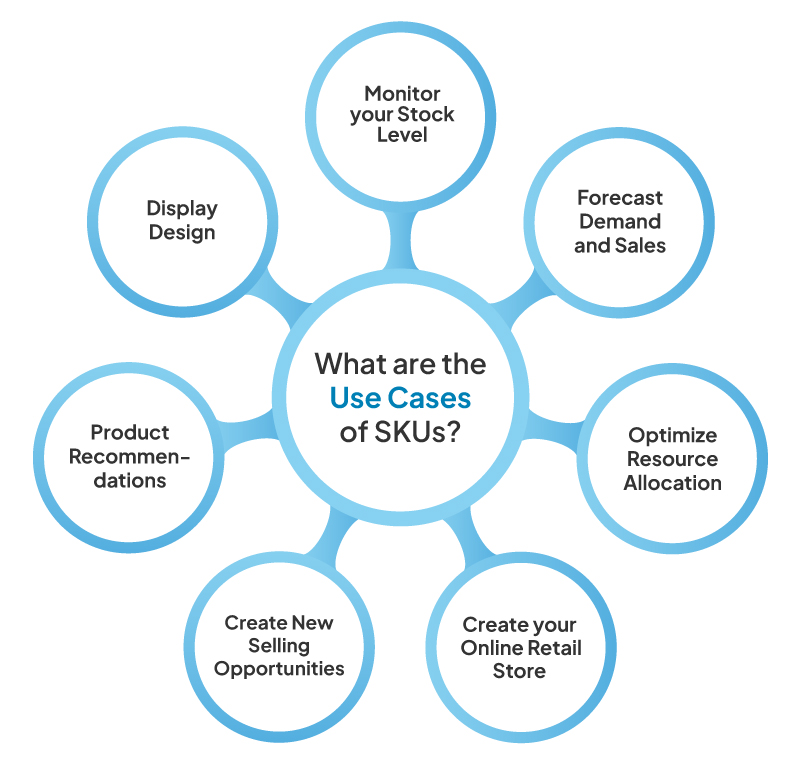
Improving in-store customer service: SKUs enable teams that interact with customers to find products more quickly, which expedites customer service encounters and increases customer satisfaction.
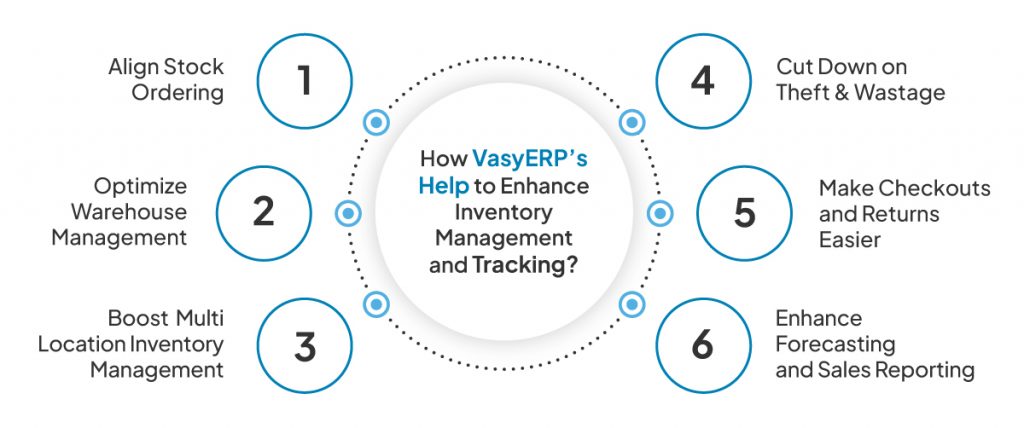
With VasyERP retailers can quickly keep an eye on inventory levels and place new orders before supply runs out by classifying products using SKUs. For instance, if a certain tshirt style in size L and blue is getting out of stock, the SKU system can automatically place a new order depending on preset levels to prevent stockouts and overstocks.
SKU numbers can be used by companies with big inventory to identify particular storage areas, speeding up stock retrieval and lowering errors. To make it easier for staff to find things, a retailer could, for instance, arrange SKUs to indicate aisle and shelf placement.
SKU numbers are a useful tool for retailers with many locations to monitor product availability in each location. Employees can swiftly determine whether an item is available in another store and set up a transfer if it is out of stock at one location, saving missed sales chances.
SKU numbers assist businesses in determining which products sell the best since they represent product information such as category, size, or color. For instance, retailers should prioritize restocking and stock up for seasonal demand if a certain SKU (such as a medium-sized red jacket) is a constant top seller.
The POS system quickly recognizes product details when SKUs are scanned at checkout, accelerating transactions and lowering mistakes. Similarly, the SKU increases inventory accuracy by ensuring that the appropriate product and variant are provided in the case of product return.
SKUs assist in identifying differences between recorded stock and real inventory since they track inventory at a fine level. The company will look into possible theft or administrative mistakes if an SKU indicates that it has 20 units in stock but only 15 are discovered during an audit.
The ideal method for tracking products internally, monitoring customer demand, and making informed business decisions based on useful sales data is to use SKU codes. Merchants can make better inventory purchase decisions, maintain inventory organization, and facilitate the search for related products by assigning each product a unique number that corresponds to its attributes. Implementing SKUs is surprisingly simple because there are not any strict guidelines. It is difficult to go wrong as long as you establish a standardized framework, make it straightforward, and maintain consistency.
However, if you want to handle everything yourself for your omnichannel retail and e-commerce then check out VasyERP’s Retail software solutions. Simplifying inventory management throughout all of your sites and warehouses will ensure that you always have the correct products at the right time.
Both UPC and SKU labels have barcodes and a string of identifying characters, and they are found on several products. The UPC code consists of strictly 12-numeric digits (without any letters). The SKU’s length varies from 8-12 characters typically consisting of both numbers and alphabetical characters. The product is identified by its UPC. The SKU identifies the product and its seller.
The acronym for stock keeping unit is SKU. For enterprises, it makes internal stock tracking and management easier.
No, the serial numbers & Stock Keeping Unit (SKUs) numbers are not identical. SKUs are specific to each product type, although serial numbers are usually unique to each item produced. For example, the same merchant would sell two identical laptops with different serial numbers but the same SKU.
No, every SKU in a company’s inventory is distinct to a single product. Assigning the same SKU to two products will result in confusion and mistakes in inventory tracking.
There is no universal standard for SKU length and format; instead, it varies based on business needs. SKUs are usually 8–12 characters long and combine letters and numbers to provide useful product information.

Excess inventory is a common issue that retailers face....
February 15, 2024
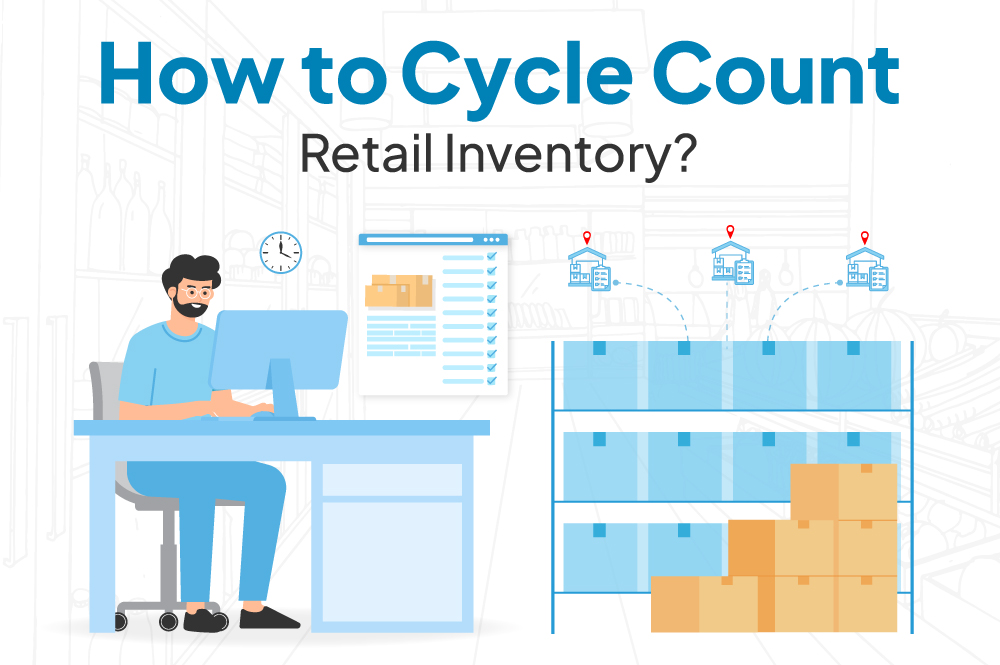
Retail business inventory refers to furnished goods or ...
June 19, 2024
